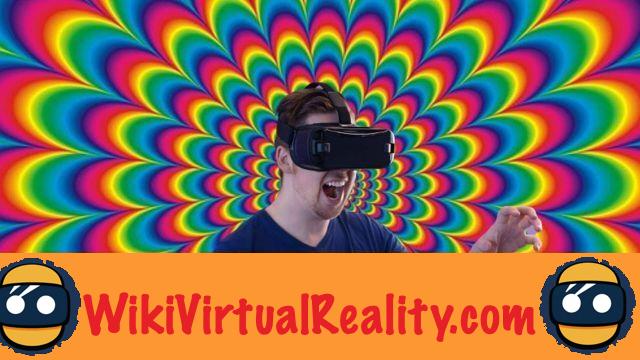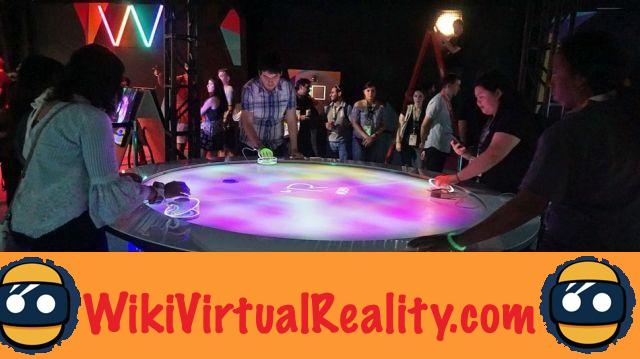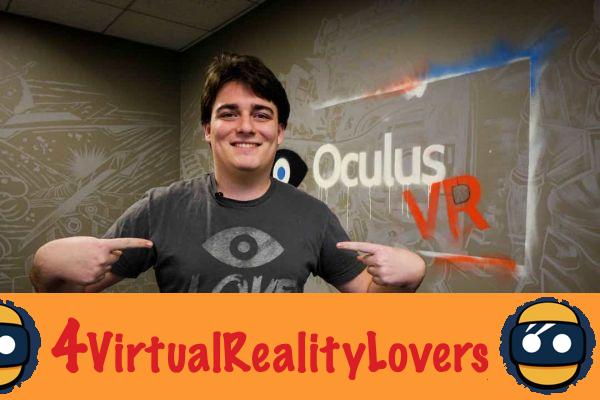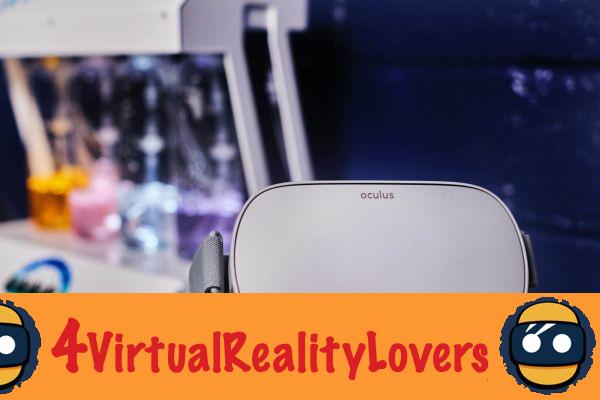
Summary
- Palmer Luckey: a teenager passionate about virtual reality
- The foundation of Oculus VR
- The Oculus Rift Kickstarter
- The Oculus Rift DK1
- The Oculus Rift DK2
- Acquisition by Facebook
- The partnership with Samsung
- Oculus Story Studio or the failure of an adventure in the world of cinema
- The launch of the Oculus Rift
- The departure of the four founders
- The Oculus Go or the beginning of the era of autonomous headsets
- The Oculus Quest: a VR headset that will be remembered
- The Oculus Quest 2: the benchmark for VR headsets
- Oculus Rift S: the “mid-life” update of the Rift
- Oculus' place in the VR market
- The future of Oculus
By launching the Oculus Rift in 2016, Oculus VR has truly launched the VR headset market General public. From this point of view, it is therefore the most important company in the virtual reality industry. Through this file, discover everything you need to know about Oculus, its history, its products and its projects for the future ...
Palmer Luckey: a teenager passionate about virtual reality

The story of Oculus begins with that of a young American named Palmer Luckey. When he was 15 years old, he developed a passion for virtual reality and began to collect old VR headsets marketed during the 80s and 90s.
During these two decades, many companies have indeed tried to bring to life the concept of virtual reality dreamed of by science fiction. In vain. At the time, the technology was not yet sufficiently advanced so that immersion in the virtual is possible.
The components were way too expensive, and the computers weren't powerful enough to run the hardware. All these VR headsets were missed, and their business failure was simply bitter.
After bringing together the largest collection of virtual reality headsets in the world, Palmer Luckey began to think about creating his own device ...
He then began to manufacture ersatz VR headsets. His ambition? Create a sufficiently successful and efficient product to convince the general public.
At first, he combines elements of the different helmets in its collection. He also tries to modify devices created by other amateurs, or directly manufactures his prototypes from spare parts.
At this point, however, Palmer Luckey did not imagine he was on the verge of forever changing the tech world and found a business that would make him a billionaire ...
The foundation of Oculus VR

While browsing the internet, around a forum, Palmer Luckey meets John Carmack : co-founder of id Software, and chief programmer of the famous video games Doom, Wolfenstein 3D and Quake.
Without this happy meeting, Oculus VR would probably never have seen the light of day. Chance doing things well, Carmack is also interested in VR and had fun modifying a headset in his possession.
Luckey then presented him with his prototype helmet, and John Carmack is directly packaged. He then asks him "if it is possible to buy one". Honored by the request of such a video game legend, the young man prefers to offer him the prototype.
A decision that will prove to be extremely beneficial for the fate of this Californian teenager. A few months later, John Carmack himself presents the device developed by Luckey on the E3 stage.
Immediately, the internet caught fire. Everyone's talking about Carmack's “new VR project,” and Palmer Luckey realizes he can't pass up the opportunity before him. In June 2012, the young man abandons his journalism studies and founds his company: Oculus VR.
Quickly, he will be joined in this company by three heavyweights of the industry seduced by the demonstration of John Carmack: Brendan Iribe, Michael Antonov and Nate Mitchell. These would become the executives of Oculus VR.
The Oculus Rift Kickstarter
Long before meeting John Carmack and founding his company, Palmer Luckey was already thinking about getting his virtual reality headset project funded through Kickstarter. However, at the time, the young man hoped at most to have the support of a hundred people and did not even plan to make a profit on this project.
On August 1, 2012, when he finally launched his campaign on the famous crowdfunding platform, the situation had changed. In addition to Carmack, other industry heavyweights such as Gabe Newell, the president of Valve, have also decided to provide support.
Despite everything, the goal set by Luckey remains relatively modest. The American is only looking to raise $ 250. However, in just 24 hours, he managed to rake in $ 670 from 000 backers. All of his expectations are far exceeded, and in just three days he manages to pass the million dollar mark.
The Oculus Rift DK1
However, the purpose of this Kickstarter was not to directly finance a product ready for marketing to the general public. Initially, Oculus wanted to develop a device intended for developers or the more enthusiastic in order to allow them to familiarize themselves with virtual reality and to erase memories of past failures.
This developer kit would be called Oculus Rift DK1. Offers for the sum of 350 dollars, the headset already far surpassed all virtual reality headsets marketed previously.
However, he clearly wasn't perfect. The screen definition was very low, and the extremely pronounced grid effect. In addition, there was no question of position tracking yet. The built-in sensors were able to detect the direction in which the user's head was facing, but not their position.
Unsurprisingly, many users were faced with to the phenomenon of Motion Sickness. Despite everything, the 65 units manufactured by the firm were officially sold on February 000, 21. Rather than ordering components to produce more, Oculus unveiled a few weeks later the second version of its developer kit.
The Oculus Rift DK2
On March 19, 2014, Oculus announced the opening of pre-orders for the DK2 of the Oculus Rift. This second iteration is still not completed enough for large-scale marketing, but is getting closer to the final version of the VR headset.
The DK2 is based on a prototype presented by Oculus a few months earlier, and corrects many faults of the DK1. The resolution of the screen goes from 640 × 800 to 960 × 1080, for a total increase in the number of pixels of more than 100%. The grid effect, meanwhile, is much less pronounced although still present.
In addition, Oculus has succeeded in partially solve the problem of Motion Sickness caused by DK1. The firm noticed that this phenomenon was mainly caused by a blur effect on the screen. To remedy this, the LCD screen has been replaced with an OLED screen. In addition, latency has been greatly reduced from 60 milliseconds to only 30 milliseconds. Finally, completely black frames are integrated between the images to give the brain an impression of increased fluidity in the scrolling of the images.
Finally, an external camera has been added to the helmet. This allows the tracking of infrared LEDs integrated into the helmet, and therefore position tracking. This is undoubtedly the main improvement of DK2 over DK1, since it opens up a myriad of new possibilities for developers ...
Acquisition by Facebook
On March 25, 2014, the news had the effect of a bomb. Mark Zuckerberg announces Facebook acquisition of Oculus for $ 2 billion. A takeover which seems to confirm that the Oculus Rift and more generally virtual reality are doomed to conquer the general public.
According to the creator of the famous social network, VR is one of the “platforms of tomorrow”. He believes that Oculus could "create the most social platform of all time and change the way we work, play and communicate." In his eyes, this technology represents the future of social networks ...
However, several Kickstarter contributors denounced this acquisition, believing it to go against the independent ideology of crowdfunding. Likewise, some big names in the video game industry, such as Minecraft developer Markus Person, also criticized this takeover.
A few days later, Michael Abrash appointed Chief Scientist of the company. In January 2015, Oculus' HQ moved from Irvine, California to Menlo Park, where Facebook's is also located. In this way, collaboration between the two companies is facilitated.
The partnership with Samsung

Before the launch of the Rift, a first headset was born following the acquisition of Oculus by Facebook. This is the Samsung Gear VR, designed in partnership with Samsung.
After being supplied to two numerous developers, the Gear VR is released on November 20, 2015. The stocks are immediately sold.
Thanks to this device, Samsung smartphone users can immerse themselves in virtual reality very easily by placing their device in the location of the helmet provided for this purpose. However, this system, which at the time looked like a revolution, quickly became obsolete. Proof that VR technology is developing quickly, very quickly ...
Oculus Story Studio or the failure of an adventure in the world of cinema
The story of Oculus is not all about successes. In 2014, the firm founded the Oculus Story Studio: a studio entirely dedicated to animated films in virtual reality.
At the time, many experts were convinced that cinema is one of the most promising application sectors for VR. Oculus wishes to be among the pioneers of this new market, and wishes to bring together a community of directors interested in this technology.
The studio is run by Pixar veteran Saschka Unseld, as Creative Director. The studio's public launch is announced at the 2015 Sundance Film Festival with the screening of three films: and.
These three projects will receive critical acclaim, and even receive a prestigious Emmy award in 2016. However, the general public is much less enthusiastic and definitely seems to prefer virtual reality for video games.
In May 2017, Facebook decides to close the Oculus Story Studio. In 2018, however, the former members created their own studio: Fable. Their first project, “l“, will be crowned with an Emmy Award in 2019.
The launch of the Oculus Rift
On March 28, 2016, the time has finally come. After all these years of effort and development, the Oculus Rift ”CV1“ is finally launched on the market in 20 countries for the price of 599 dollars.
This device is vastly improved compared to the Crescent Bay prototype, and delivers a definition of 1920 × 1080 per eye significantly higher than the DK2. The volume of position tracking is also greatly increased.
Un 3D headphones are finally integrated. The emphasis is also placed on ergonomics and aesthetics since this product is intended for the general public.
Le success is immediate, and those who did not immediately pre-order the device in January must wait until July. A shortage of components forces some buyers to wait three to eight weeks.
This device truly marks the beginning of the age of consumer VR headsets. It will be followed the following month by the first HTC Vive. However, this is only the beginning ...
The departure of the four founders
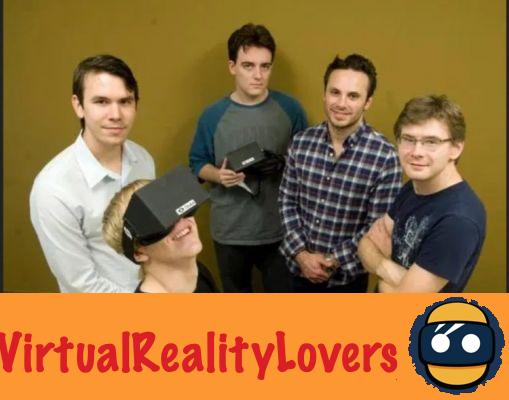
Following the acquisition of Oculus VR, Palmer Luckey joins Facebook alongside John Carmack and the three other co-founders of the company: Nate Mitchell, Michael Antonov and Brendan Iribe.
However, over the years, all original members of Oculus VR left the adventure one by one. In March 2017, Palmer Luckey left Facebook without any explanation being given. He would later admit to having been driven out because of his funding from a support group for Donald Trump, even though Mark Zuckerberg has repeatedly asserted that his dismissal had nothing to do with politics.
Subsequently, in June 2017, he co-founded the company Anduril specialized in military technologies. This firm has notably developed a system to automatically detect illegal migrants trying to access Texas from Mexico City. During the pilot program organized by the American government, 55 illegal immigrants were caught in twelve days ...
At the end of 2018, it was Oculus CEO Brendan Iribe who decided to leave the ship. His departure is linked to disagreements with Facebook about the future premium Oculus products. While Facebook's priority is to lower the prices of headsets, Iribe wanted to continue developing products that push the limits of technology.
Then, in August 2019, it's Nate Mitchell's turn, software architect, to announce his resignation. In his own words, he wants to "continue on his way" and take a break to "recharge and spend time with his family".
In November 2019, John Carmack left the position of CTO of Oculus, which he had held since 2013. The eminent technical manager indeed wants to abandon virtual reality to work on another technology of the future: artificial intelligence.
By his own admission, Carmack was not happy with the slow pace at which the VR industry has grown. Disappointed, he will nevertheless remain a “CTO consultant” for Oculus and will continue to devote “a modest part of its time” to certain virtual reality projects.
From now on, Michael Antonov is the last founder Oculus still present at Facebook. However, he holds the position of software architect for the AI infrastructure team. He is therefore no longer affiliated with the VR team. We can therefore consider that Oculus is now fully owned by Mark Zuckerberg ...
The Oculus Go or the beginning of the era of autonomous headsets
In October 2017, Facebook launched the Oculus Go. This VR headset, made by the Chinese Xiaomi, is one of the first autonomous VR headsets. Understand by this that it can work without being connected to a smartphone or a PC.
The device embarks its own 5,5-inch 1440p LCD screen, its integrated speakers, its Snapdragon 821 processor, its storage chip, its battery and its sensors. It runs on an Android based OS and the Oculus Store allows you to download games and apps.
- performance is comparable to that of Gear VR, and position tracking is not supported. However, this product is very successful because of its affordable price. In January 2019, the Go crossed the mark of one million units sold. In addition, this first autonomous headset inaugurates a new era for virtual reality and lays the foundations for the revolution that is brewing ...
The Oculus Quest: a VR headset that will be remembered
September 26, 2018, as part of the Oculus Connect 5 conference, Facebook unveils a second autonomous headset: the Oculus Quest. Like the Go, this device includes all the hardware necessary for its operation.
However, it is clearly more efficient thanks to a Snapdragon 835 chip, a 1600 × 1400 OLED screen per eye at 72Hz, and above all an inside-out tracking system called Oculus Insight.
Unlike that of the Rift, this tracking system does not rely on external sensors, but on cameras integrated into the helmet. This allows you to take advantage of a six-degree freedom of movement that was sorely lacking in the Go, and a room-scale tracking for maximum immersion. In addition, the Quest comes with a new, more ergonomic version of the Oculus Touch controllers.
From its launch in May 2019, the device is a phenomenal success and surpasses all analysts' forecasts. Quick to install, easy to use, affordable in terms of price and powerful enough to run real VR games… the Quest has all the qualities to finally democratize virtual reality.
Facebook east overwhelmed by success and struggling to produce enough units to answer the question. Unsurprisingly, developers are setting their sights on this platform and many quality games and software come to expand the Oculus Store.
A few months later, during the Oculus Connect 6, Facebook announced new features for the Quest. A hand-tracking system allowing interaction without a controller, and an Oculus Link cable allowing the Quest to be connected to a PC to access Rift applications.
With these new features, the Oculus Quest now dominates the VR headset market and seems difficult to dethrone. Without a doubt, this device will be remembered and could allow Mark Zuckerberg to achieve his goal: to attract a billion people into virtual reality ...
The Oculus Quest 2: the benchmark for VR headsets
the reference heir of the first Quest13th October
lighter, smaller and more powerful than the original Oculus QuestSnapdragon XR26 GB of RAM250 GB storage 50% more pixels
achieve awesome VR experiences
1832 x 1920 per eyerefresh rate up to 90Hzinspired by original Rift touch controllers
smaller and lighter than the original Oculus Questthe Elite Strapreduces the pressure exerted by the front of the helmet
Oculus Quest 2: an undeniable success

a real enthusiasm with the public
increase sales by 156%
ahead of the PSVR in number of units sold
Oculus Rift S: the “mid-life” update of the Rift
Along with its standalone Oculus Quest headset, Facebook also announced a new PC VR headset: the Oculus Rift S.
This device was launched in May 2019, the same day as the Oculus Quest. His price is also the same to that of the all-in-one headset.
This new product comes replace the Rift and make several improvements. Designed in partnership and manufactured by Lenovo, it is distinguished by a more ergonomic design designed by the Chinese manufacturer. The main difference is a halo-shaped visor.
In addition, built-in speakers have been added. We also find the 1440p screen and lenses of the Oculus Go, for increased definition compared to the first Rift. However, the definition of the Rift S is lower than that of the Quest.
Le Oculus Insight tracking system, introduced with the Quest, is taken over by the Rift S. There is therefore no need for external sensors, as was the case with the first Rift. Cameras are integrated into the helmet. Room-scale tracking is greatly facilitated.
Apart from these novelties, the Rift S is a direct successor to the Rift. It is compatible with the entire Rift Oculus Store catalog which will no longer be produced.
Due to its price identical to that of the Quest, the Rift S offers an interesting alternative only for those who already have a VR-Ready PC. However, with the launch of the Oculus Link cable, it is now possible to connect the Quest to a VR-Ready PC to access the Rift S catalog ...
Oculus' place in the VR market
It is difficult to accurately estimate the market shares of Facebook and Oculus in the virtual reality market. Because, the company does not disclose the number of sales of its various devices.
Si we trust the analysts of Statista, however, Oculus would have sold 250 Rift headsets in 000, then 2016 headsets in 700, 000 in 2017 and 900 in 000. In terms of revenue generated by hardware, software and games, the firm would have gone from about $ 2018 million in 1 to over $ 700 billion in 000.

In the past, the VR market was largely dominated by Sony with its PSVR. The Japanese firm would have sold 1,7 million helmets in 2017, 2 million in 2018 and 2,2 million in 2019.
However, we see that the gap with Oculus narrows over time. In 2018, Sony captured 43% of the VR headset market against 19,4% for Oculus. In 2019, Sony's shares fell to 36,7% while Oculus' shares jumped to 28,3%.
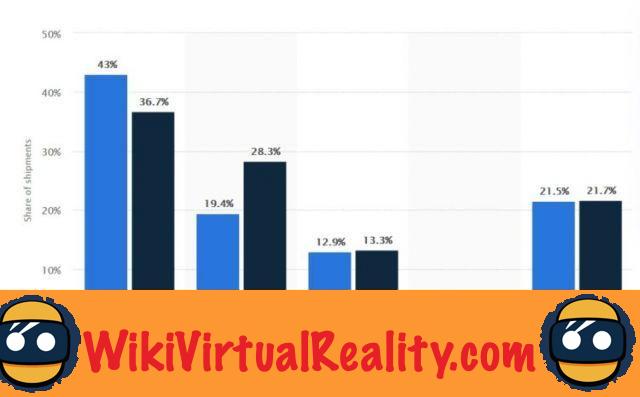
Cette redistribution of cards can be explained by several phenomena. Facebook's Oculus Quest, launched in 2019, has seen phenomenal success. For its part, the PlayStation VR is aging and technically obsolete against the competition. In 2020, we can therefore expect Facebook to take precedence over Sony.
To compare, HTC Vive takes third place of the market with 13,3% share in 2019. Microsoft is far behind with just over 3%. Finally, the other manufacturers accumulate 21,7% of PdM.
The future of Oculus
Virtual reality is an emerging technology, and we are obviously only at the beginnings. Going forward, VR will continue to evolve at a frantic pace and many surprises await us for the next few years.
For its part, Facebook takes advantage of its annual Oculus Connect conference each year to unveil its plans for the future. The research director, Michael Abrash, notably delivers his predictions for the long term based on the work of the Facebook Reality Labs he runs.
In 2014, during the first conference, he believed that VR was finally going to democratize. Among the technologies of the future, Abrash cited in particular eye-tracking and foveal rendering. In 2015, he explained how our different senses would be stimulated by the VR of the future.
The expert also unveiled the technical sheet for the VR headset of tomorrow, free from current technical constraints. This device would offer a field of view greater than 220 degrees, image quality greater than 120 ppd with a 4K display, and an HDR of around 10 orders of magnitude. Finally, this wireless device would have the design of simple sunglasses.
In 2016, during the Oculus Connect 3, shortly after the launch of the Rift, Abrash predicted the arrival of technologies like wireless VR and hand-tracking. In 2020, these innovations took shape with the Oculus Quest.
In 2018 and 2019, however, the man revised his predictions for the ultimate VR glasses of the future. According to him, this new generation of devices will not finally see the light of day in the near future and it will therefore be necessary to wait for many years...
Along with this “perfect” VR headset, Facebook is also developing ultra-realistic avatars for virtual reality. The objective is to allow the presence to be perfectly simulated for make “social VR” applications more interesting.
In addition, Facebook is also preparing augmented reality glasses. It is probable that this device also be launched under the Oculus brand. However, it is not yet clear how soon this device will be launched ...




